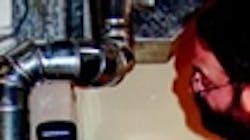Air for combustion is divided into four types, depending on its role and the design of the particular burner: Primary air provides a percentage of the combustion air, but more importantly, controls the amount of fuel that can be burned.
Secondary air improves combustion efficiency by promoting the fuel to burn completely. Power burners generally do not require secondary air. However, air leaking in through access/clean out doors, burner mounting flanges, boiler sections, etc., dilutes the flame and flue gas temperatures, reducing operating efficiencies as well as our ability to accurately monitor combustion conditions.
Excess air is supplied to the combustion process to ensure each fuel molecule is completely surrounded by sufficient combustion air. As a burner tune-up improves the rate at which mixing occurs, the amount of excess air required can be reduced.
Dilution air does not participate directly in the combustion process, and is primarily required to attempt to control stack draft and reduce the likelihood that moisture in the flue gasses will condense in the vent system, which directly influences combustion air intake, safety, and efficienty.
Commonly used fuels such as natural gas and propane generally consist of carbon and hydrogen. When a fuel has a large ratio of hydrogen, more excess air must be provided. Water vapor is a byproduct of burning hydrogen. To maintain its vaporous state, it robs heat from the flue gases, which would otherwise be available for more heat transfer.
Natural gas contains more hydrogen and less carbon per BTU than fuel oils, and as such produces more water vapor. Consequently, natural gas is generally slightly less efficient than fuel oil.
Too much or too little fuel with the available combustion air may potentially result in unburned fuel and carbon monoxide generation.
A very specific amount of O2 is needed for perfect combustion, and additional (excess) air is required for good combustion. Too much additional air can contribute to CO generation, lower efficiencies, and perhaps unsafe conditions with heating equipment not outliving its full service life.
A number of experiments have shown that when 1 lb. of carbon is burned to CO2, 14,000 BTUs are produced. When 1lb. of carbon is burned to CO, only 10,200 BTUs are produced, 4,400 less BTUs or heat.
Also, carbon may be become deposited on heat exchanger walls or vent systems surfaces, which further reduces efficiency, and/or increases safety risks.
The following table provides a guide to combustion troubleshooting.
Bob Dwyer is director of training for Bacharach, Inc. He can be reached at [email protected]
Carbon burned to CO2 produces more heat per pound of fuel than when CO or smoke are produced.
Combustion analyzers measure the number of CO molecules present in a million molecules of air.
Problem | Probable Cause | Remedy |
| Insufficient O2 and /or excess carbon monoxide production | Insufficient combustion air | Adjust air band setting(s) |
| Burner over-firing | Check for adequate combustion air into the furnace zone | |
| Low stack draft | Adjust fuel input | |
| Adjust/install barometric control | ||
| Check for restricted heat exchanger or vent system | ||
| Check for improperly / properly sized or constructed chimney or vent system | ||
| High O2 reading | Excess combustion air | Adjust air band setting(s) |
| Burner under-firing | Adjust fuel input | |
| Loose clean-out ports, access doors, gasket missing in boiler sections, etc. | Repair | |
| Excess stack draft | Adjust/install barometric control | |
| Fluctuation in O2 and/or carbon monoxide readings | Changing atmospheric conditions (i.e., wind speed) | Evaluate for barometric control |
| Cracked heat exchanger | Replace | |
| Loose clean out ports or gasket missing in boiler sections | Repair | |
| Excess stack temperature | Inadequate air flow across the heat exchanger | Check for dirty filter, blower, and/or air conditioning coil |
| Increase blower speed. Don't over-amp motor! | ||
| Increase return or supply ducting if necessary | ||
| Insufficient stack temperature | Burner underfired | Adjust fuel input |
| Excess air flow past heat exchanger | Check temperature rise per manufacturers' instructions | |
| Low temperature rise | High fan speed | Decrease fan speed or baffle blower to reduce air flow |
| Burner underfired | Adjust fuel input | |
| Low stack draft: less than -.02 WC in. in flue or (gas); less than -.04 WC in. WC in. over fire with gas or oil power burners | Improperly sized vent connector or chimney | Properly size system |
| Blocked vent system | Remove blockage | |
| Excess elbows, long horizontal runs | Re-vent or move appliance to better location for venting | |
| Leakage in chimney or vent connections | Seal | |
| Improper vent termination | Re-vent | |
| Inadequate combustion air | Add combustion air | |
| Improperly adjusted barometric control | Adjust | |
| High stack draft: greater than .04 WC in. in flue (gas); greater than .06 WC in. in flue (oil); greater than .02 WC in. over fire with gas or oil power burners | Improper vent system sizing | Properly size system |
| Absence of or improperly adjusted barometric control | Install or adjust barometric control |
